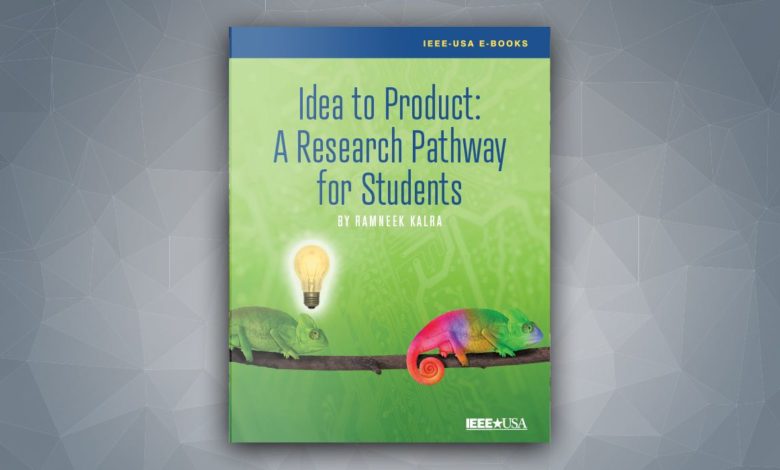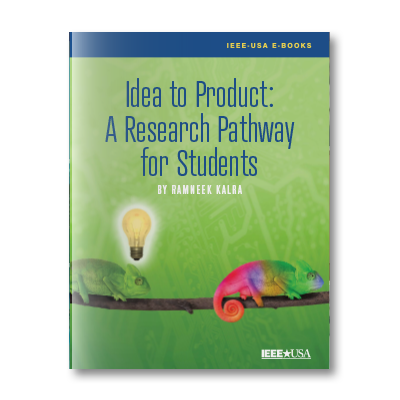

Idea to Product – A Research Pathway for Students
FREE to Members
Non-Members: $2.99
People have said that pure randomness determines much of life.
That was certainly the case when Ramneek Kalra’s (then a high school student learning JAVA) IT instructor asked him to write a very simple program for calculating simple interest.
“At that moment, I started thinking about developing banking software with many options to handle loans, accounts, and other related activities,” he says. “For my final exams, I ended up developing a JAVA-based software prototype that both banks and account holders could use.”
This purely random assignment triggered a breakthrough for Kalra: thinking from the perspective of a customer/user. He also found a new passion – inspiring other students to understand the process of transforming an idea into a product. Now a project engineer at Wipro Limited in New Delhi, India, this IEEE Member has written the IEEE-USA E-Book, Idea to Product-A Research Pathway for Students. IEEE-USA is offering the book at no charge to members and for $2.99 to non-members, at https://ieeeusa.org/shop.
“I feel it is very important for students around the world, studying in secondary schools and universities, to understand the process of transforming an idea into a product,” he writes, in the e-book introduction.
Kalra sees the development of this concept as five specific phases:
- Determining the problem, then developing problem statements and solutions
- Choosing the right team and the right technology
- Conducting in-depth research and a literature survey
- Developing the prototype
- Securing intellectual property rights
The author devotes a detailed chapter to each. For example, in his discussion about determining problem statements and solutions, Kalra suggests that just standing in a long line for any of myriad services – shopping and public transportation among them – can spark the idea. He encourages forming a problem statement as the first step to solving the problem.
“A problem statement is a concise explanation of what gaps exist between the current state and the goal of a product,” Kalra writes. “It reflects not just the simplicity of facts and figures, but also the possibility of a solution not available at the current time.”
To develop the problem statement, Kalra recommends the “Five W’s” – Who, What, When, Where and Why. However, he modifies what are customarily the five rules for journalists acquiring information to that of product development. “Who” should answer the question about users of the current model. “What” is the application or usage of the current model,” he says. “When” is the best time to bring the solution to market. “Where” identifies the place to deploy the solution, and “Why” explains why the current approach is not suitable.
Kalra continues that when all the “W’s” are established, it’s time to loop in the three “How” questions.
“How has this problem occurred?” he writes, continuing with “How can I solve this problem using my current knowledge and understanding?” and “How should I proceed?”
Discussing the importance of in-depth research and a survey of the literature, Kalra is practical and informative. He observes that the task of researching existing solutions, then comparing them with similar or related ideas is simple, but can be daunting.
“Many students are intimidated by this stage of the journey,” Kalra says. “It takes a lot of time, devotion and patience, and also requires a strong focus on the topic you are researching.”
He recommends starting with the basic task of reading available public information on the internet, and he helpfully includes links to several key research resources. He especially encourages using the public research portal of the IEEE Xplore Digital Library. A list of thoughtfully provided references at the end of this e-book includes a link to tips on searching in Xplore.
Kalra’s discussion of intellectual property rights is to the point. “IP protects your prototype or project in a relevant domain,” he explains. “From a student’s point of view, you can consider two universal options to secure your intellectual property: documenting the innovation (by writing research papers), or applying for a patent.
The author provides a detailed list of components to include in a research paper, but he also offers guidance for those readers who want to file for a patent. Kalra notes that deciding between a research paper and a patent application must be an “either/or” decision. “If you have already published a research paper on the content or idea, you can’t subsequently apply for a patent,” he says. “In addition, if you apply for a patent, you cannot share any details of your idea either before or during the application process.”
Ramneek Kalra’s e-book on how students can transform an idea into a product should inspire many engineering students to seek out and develop their own problem-solving concepts. A graduate of the HMR Institute of Technology Management (HMRITM) in New Delhi, India, he is active in IEEE Young Professionals, the IEEE New Delhi Section, the IEEE Computer Society and other entities, including IEEE Smart Village. As a student, he was chair of the IEEE HMRITM Student Branch.
Helen Horwitz is an award-winning freelance writer who lives in Albuquerque. She was with IEEE from 1991 through 2011, the first nine as Staff Director, IEEE Corporate Communications.






